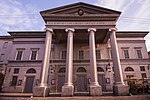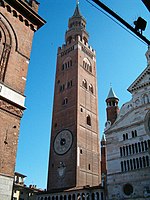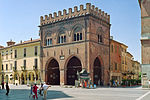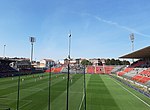Cremona railway station
Buildings and structures in CremonaRailway stations in Italy opened in 1863Railway stations in Lombardy

Cremona railway station (Italian: Stazione di Cremona) is the main station serving the city and comune of Cremona, in the region of Lombardy, northern Italy. Located on the Pavia–Mantua railway, it is terminus of the lines linking Cremona with Treviglio, Brescia, Piacenza and Fidenza. The station is currently managed by Rete Ferroviaria Italiana (RFI). However, the commercial area of the passenger building is managed by Centostazioni. Train services are operated by Trenord and Trenitalia.
Excerpt from the Wikipedia article Cremona railway station (License: CC BY-SA 3.0, Authors, Images).Cremona railway station
Piazza Della Stazione, Cremona Sant'Ambrogio
Geographical coordinates (GPS) Address Nearby Places Show on map
Geographical coordinates (GPS)
| Latitude | Longitude |
|---|---|
| N 45.143333333333 ° | E 10.017777777778 ° |
Address
Piazza Della Stazione
26100 Cremona, Sant'Ambrogio
Lombardy, Italy
Open on Google Maps








